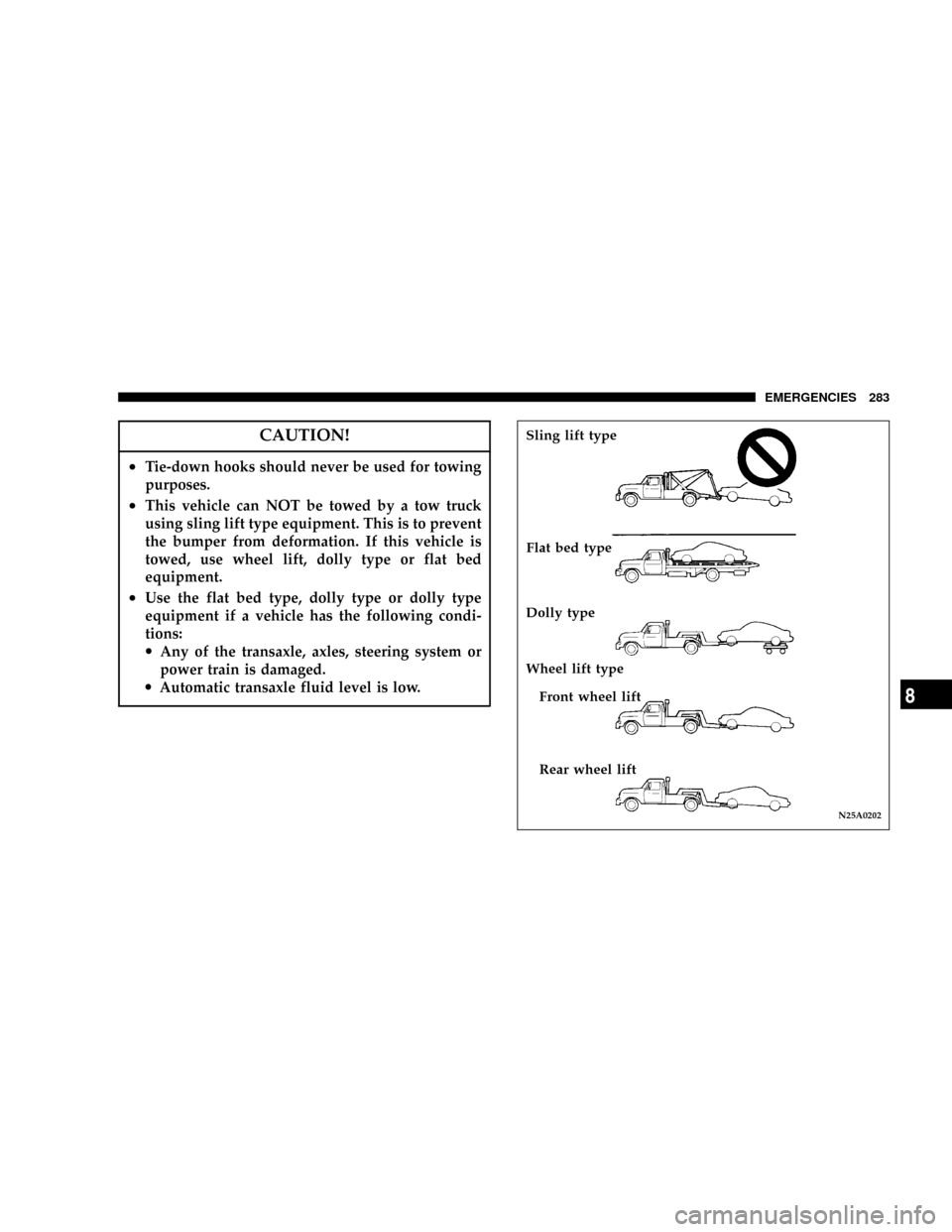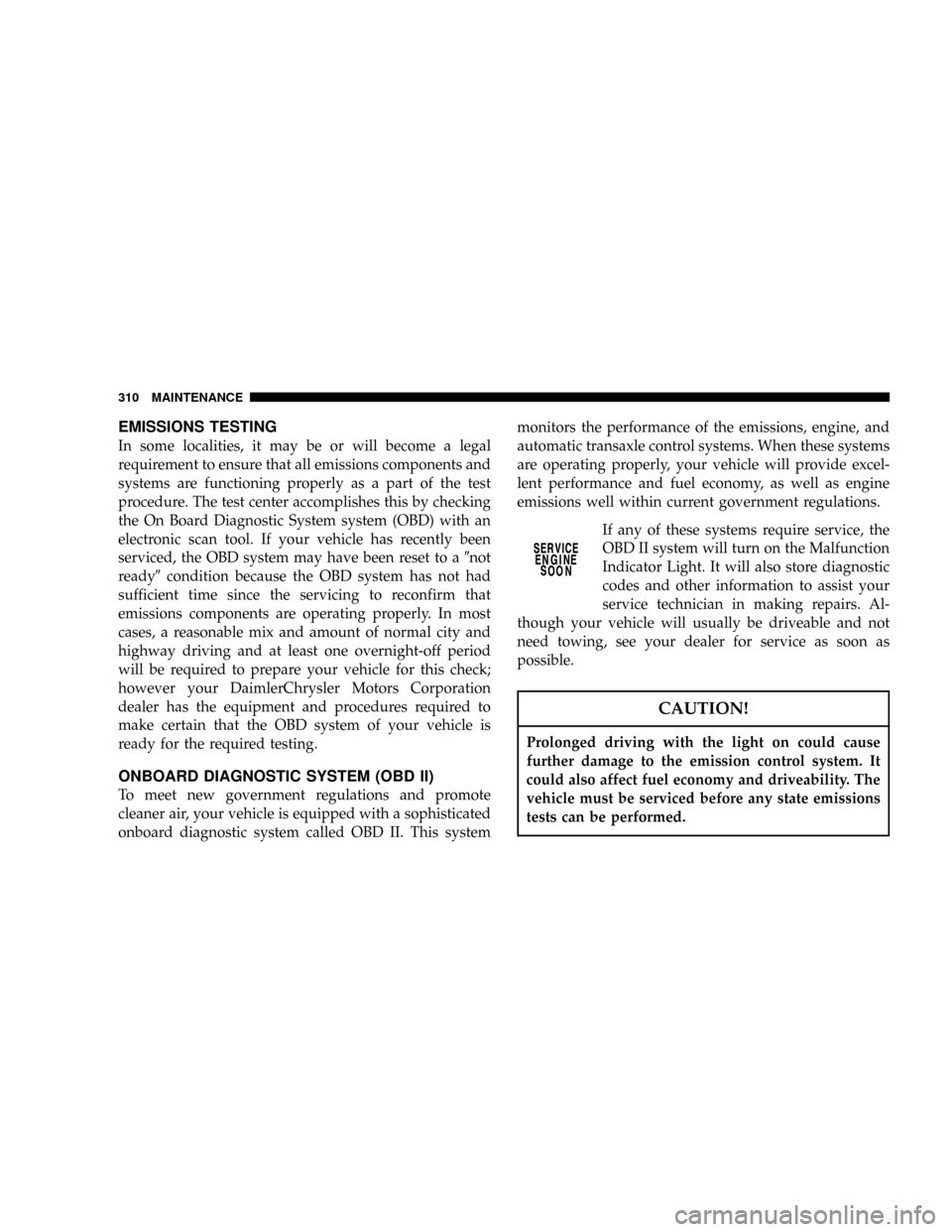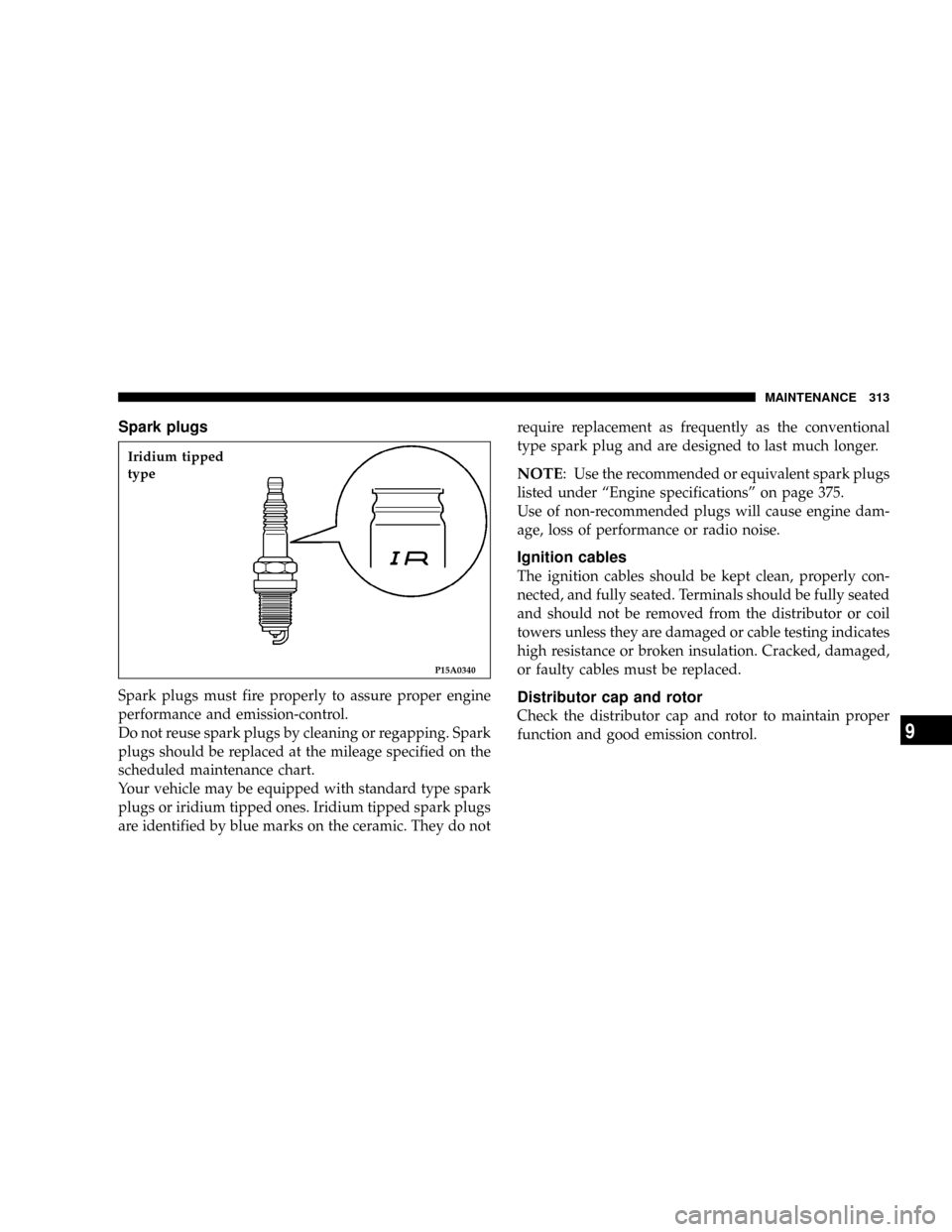tow CHRYSLER SEBRING COUPE 2005 2.G Owner's Guide
[x] Cancel search | Manufacturer: CHRYSLER, Model Year: 2005, Model line: SEBRING COUPE, Model: CHRYSLER SEBRING COUPE 2005 2.GPages: 394, PDF Size: 2.47 MB
Page 283 of 394

CAUTION!
²Tie-down hooks should never be used for towing
purposes.
²This vehicle can NOT be towed by a tow truck
using sling lift type equipment. This is to prevent
the bumper from deformation. If this vehicle is
towed, use wheel lift, dolly type or flat bed
equipment.
²Use the flat bed type, dolly type or dolly type
equipment if a vehicle has the following condi-
tions:
·Any of the transaxle, axles, steering system or
power train is damaged.
·Automatic transaxle fluid level is low.
N25A0202
Sling lift type
Flat bed type
Dolly type
Wheel lift type
Front wheel lift
Rear wheel lift
EMERGENCIES 283
8
Page 284 of 394

CAUTION!
²Towing should only be done by a professional
tow service particularly if it will involve towing
on winding roads, hills or heavy traffic. If you
have any doubts, use a professional tow service.
TowingÐfront wheel lift
Place the gearshift lever (manual transaxle) to Neutral or
the selector lever (automatic transaxle) in the ªNº (NEU-
TRAL) position. Release the parking brake.
TowingÐrear wheel lift
Turn the ignition key to the ªACCº position and secure
the steering wheel in a straight-ahead position with a
rope or similar device. Never place the ignition key in the
ªLOCKº position. This will result in damage to the
steering lock mechanism.
If you have to tow an automatic transaxle model with the rear
wheels raised (with the front wheels on the ground):
Observe the following restricted towing speeds and distances.
·Speed: 30 mph (50 km/h)
·Distance: 18 miles (30 km)
CAUTION!
Never tow an automatic transaxle model with the
rear wheels raised (with the front wheels on the
ground) when the automatic transaxle fluid level is
low. This may cause serious and expensive damage
to the transaxle.
FUSES
N09A1230
Passenger compartment
284 EMERGENCIES
Page 310 of 394

EMISSIONS TESTING
In some localities, it may be or will become a legal
requirement to ensure that all emissions components and
systems are functioning properly as a part of the test
procedure. The test center accomplishes this by checking
the On Board Diagnostic System system (OBD) with an
electronic scan tool. If your vehicle has recently been
serviced, the OBD system may have been reset to a9not
ready9condition because the OBD system has not had
sufficient time since the servicing to reconfirm that
emissions components are operating properly. In most
cases, a reasonable mix and amount of normal city and
highway driving and at least one overnight-off period
will be required to prepare your vehicle for this check;
however your DaimlerChrysler Motors Corporation
dealer has the equipment and procedures required to
make certain that the OBD system of your vehicle is
ready for the required testing.
ONBOARD DIAGNOSTIC SYSTEM (OBD II)
To meet new government regulations and promote
cleaner air, your vehicle is equipped with a sophisticated
onboard diagnostic system called OBD II. This systemmonitors the performance of the emissions, engine, and
automatic transaxle control systems. When these systems
are operating properly, your vehicle will provide excel-
lent performance and fuel economy, as well as engine
emissions well within current government regulations.
If any of these systems require service, the
OBD II system will turn on the Malfunction
Indicator Light. It will also store diagnostic
codes and other information to assist your
service technician in making repairs. Al-
though your vehicle will usually be driveable and not
need towing, see your dealer for service as soon as
possible.
CAUTION!
Prolonged driving with the light on could cause
further damage to the emission control system. It
could also affect fuel economy and driveability. The
vehicle must be serviced before any state emissions
tests can be performed.
310 MAINTENANCE
Page 313 of 394

Spark plugs
Spark plugs must fire properly to assure proper engine
performance and emission-control.
Do not reuse spark plugs by cleaning or regapping. Spark
plugs should be replaced at the mileage specified on the
scheduled maintenance chart.
Your vehicle may be equipped with standard type spark
plugs or iridium tipped ones. Iridium tipped spark plugs
are identified by blue marks on the ceramic. They do notrequire replacement as frequently as the conventional
type spark plug and are designed to last much longer.
NOTE: Use the recommended or equivalent spark plugs
listed under ªEngine specificationsº on page 375.
Use of non-recommended plugs will cause engine dam-
age, loss of performance or radio noise.
Ignition cables
The ignition cables should be kept clean, properly con-
nected, and fully seated. Terminals should be fully seated
and should not be removed from the distributor or coil
towers unless they are damaged or cable testing indicates
high resistance or broken insulation. Cracked, damaged,
or faulty cables must be replaced.
Distributor cap and rotor
Check the distributor cap and rotor to maintain proper
function and good emission control.
P15A0340
Iridium tipped
type
MAINTENANCE 313
9
Page 340 of 394

²Vehicle capacity weight : the rated cargo and lug-
gage load plus 150 lbs (68 kg) times the vehicle's
designated seating capacity.
²Production options weight : the combined weight of
those installed regular production options weighing
over 5 lbs. (2.3 kg) in excess of those standard items
which they replace, not previously considered in
curb weight or accessory weight, including heavy
duty brakes, ride levelers, roof rack, heavy duty
battery, and special trim.
²Normal occupant weight : 150 lbs (68 kg) times the
number of specified occupants. (In your vehicle the
number is 3)
²Occupant distribution : distribution of occupants in
a vehicle as specified. (In your vehicle the distribu-
tion is 2 in front, 1 in second seat)
Steps for Determining Correct Load Limit
1. Locate the statement ``The combined weight of occu-
pants and cargo should never exceed XXX pounds'' on
your vehicle's placard.2. Determine the combined weight of the driver and
passengers that will be riding in your vehicle.
3. Subtract the combined weight of the driver and pas-
sengers from XXX kilograms or XXX pounds.
4. The resulting figure equals the available amount of
cargo and luggage load capacity. For example, if the
``XXX'' amount equals 1400 lbs. and there will be five 150
lb. passengers in your vehicle, the amount of available
cargo and luggage load capacity is 650 lbs (1400-750
(5x150) = 650 lbs.
5. Determine the combined weight of luggage and cargo
being loaded on the vehicle. That weight may not safely
exceed the available cargo and luggage load capacity
calculated in Step 4.
6. If your vehicle will be towing a trailer, load from your
trailer will be transferred to your vehicle. Consult this
manual to determine how this reduces the available
cargo and luggage load capacity of your vehicle.
NOTE:The above steps for determining correct load
limit were written in accordance with U.S.A. regulations.
Your vehicle cannot tow a trailer, so step 6 is irrevelant.
340 MAINTENANCE
Page 341 of 394

NOTE
1. The following table shows examples on how to calcu-
late total cargo/load capacity of your vehicle with a
varying seating configurations and number and size of
occupants. This table is for illustration purposes only and
may not be accurate for the seating and load capacity of
your vehicle.
2. For the following example the combined weight of
occupants and cargo should never exceed 865 lbs. (392
kg).
3. Under a maximum loaded vehicle condition, gross
axle weight ratings (GAWR's) for the front and rear axles
must not be exceeded. For further information on
GAWR's, vehicle loading and trailer towing, see the
``Specifications'' section of this manual.
MAINTENANCE 341
9
Page 394 of 394

Tire chains.......................... 345
Tread wear indicators.................. 343
Tools................................ 264
Towing.............................. 282
Trailering........................... 203
Trailer Towing......................... 203
Transaxle
Automatic transaxle................... 153
Autostick........................... 163
Manual transaxle..................... 166
Transmission
Automatic transmission................ 158
Transmitter, Garage Door Opener........... 132
Transporting Pets....................... 102
Trip odometer......................... 106
Trip odometer reset button................ 106
Trunklid .............................. 35
Turbocharger boost gauge................ 106
Turn signal indicators.................107,112
Lever.............................. 122
Uniform Tire Quality Grades.............. 385
Universal Transmitter.................... 132Vanity mirror.......................... 209
Vehicle Identification Number............... 5
Vehicle labeling........................ 370
Vehicle Weights........................ 373
Ventilators............................ 235
Warnings and Cautions.................... 5
Warranty Information.................... 380
Washer fluid level indicator............... 107
Washer
Windshield.......................128,329
Washing.............................. 253
Waxing.............................. 255
Wheel covers.......................... 266
Whip antenna......................... 219
Windshield washers..................128,329
Windshield wiper blades................. 329
Windshield wipers...................... 126
394 INDEX